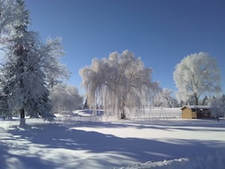Preventative Tree Care - Storm Risk Assessment Service

While spring and summer time is the most active for tree service companies and their customers, it is also a great time to have your trees inspected for risk associated with potential storm damage that could occur in the autumn and winter seasons. As part of our routine tree health care service, we can provide you with a risk assessment for all the trees in your landscape, which will minimize the impacts snow, ice, and wind may have on them later in the year and next. Our three-phase approach in providing this service is:
- Take early action
- Full inspection and assessment
- Multi-faceted treatment approach
Early Action
We advise our existing and prospective customers who call for tree care estimates to be proactive in taking early action in having their trees inspected and assessed for storm-related damage (both existing damage as well as potential risk for future damage). Winters in the Midwest can be brutal with the occasional blizzard wreaking havoc on our trees. Therefore, it is prudent to have your trees evaluated annually and no later than August of each year.
Full Inspection and Assessment
Our primary objective when inspecting your trees is to assess which trees and branches are most at risk for breakage during strong winter storms and ice. While it is impossible to be 100% accurate in these inspections, our tree care experts can identify signs and symptoms on most trees that could lead to tree failure. Here is a list of indicators that we inspect:
Upon completion of the inspection, Cedar Rapids Tree Service can devise the proper course of action to minimize and even eliminate future tree-storm damage. While removal of part or entire trees that fail our inspection is prudent, wholesale removal of salvageable trees is not. Trees provide protection again strong storms, wind, and ice. You want to maintain as much of that healthy protection as possible.
- Overall Structure - We evaluate the overall limb size on mature trees, which is ideally two-thirds the diameter of the trunk. And, on most shade trees we want to see one primary trunk leader growing up to the top of the tree. A tree that is leaning can often be natural and normal. Trees do naturally lean (or grow) towards sunlight and away from prevailing winds. However, a lean can also be indicative of a weakening root system, suggesting the tree might be susceptible to storm damage.
- Weak Branches - branches absent bark or leaves is a dead wood sign. Such limbs are a top priority to remove ahead of the upcoming season. These types of limbs will crack, break, and fall very easily in even mild storms. Additionally, branches with holes, wounds, or cavities might also be a sign that disease is impacting the tree. Lastly, a branch that has grown larger than the trunk is typically beyond the carrying capacity of that tree and should be preventatively removed.
- Root System - if you see exposed roots, which are not protected by a layer of soil, you should be concerned about the strength of those roots. Additionally, damaged or even severed roots can result when a structure, such as a street or sidewalk, comes into contact with growing roots. Symptoms of damaged roots include one face of the tree declining or even dying, scarification of the buttress-root area. or fungal fruiting growths.
Upon completion of the inspection, Cedar Rapids Tree Service can devise the proper course of action to minimize and even eliminate future tree-storm damage. While removal of part or entire trees that fail our inspection is prudent, wholesale removal of salvageable trees is not. Trees provide protection again strong storms, wind, and ice. You want to maintain as much of that healthy protection as possible.
Multi-faceted Treatment Approach
After our assessment, at-risk and weak trees can be identified on your property and a storm-prep plan can be developed to address the vulnerabilities identified. Here are some of the most common services we provide to address at-risk trees:
Call the tree service Cedar Rapids trusts to ensure their trees can survive our cold, hard winters. We offer free preventative tree care estimates.
- Trimming and pruning dying or deadwood as well as identified weak limbs
- Bracing and/or cabling of overgrown branches as well as multi-trunks
- Watering and fertilization to ensure your trees have the necessary nutrients to remain healthy and strong during the winter months
- Removal of trees assessed to be already hazardous or too vulnerable to weather storms
Call the tree service Cedar Rapids trusts to ensure their trees can survive our cold, hard winters. We offer free preventative tree care estimates.
